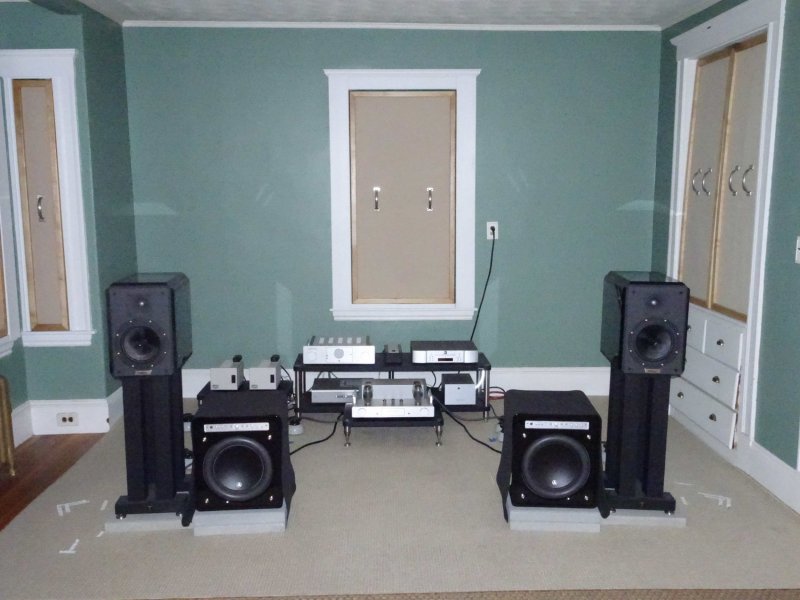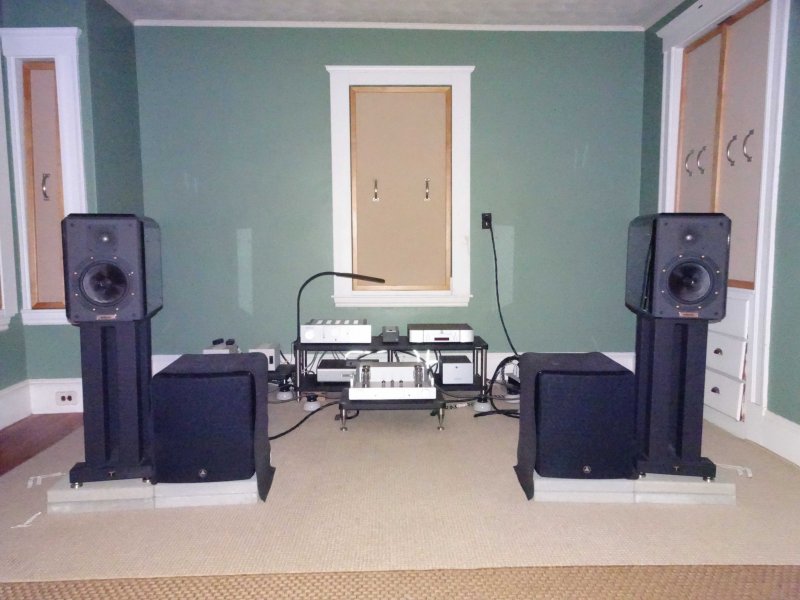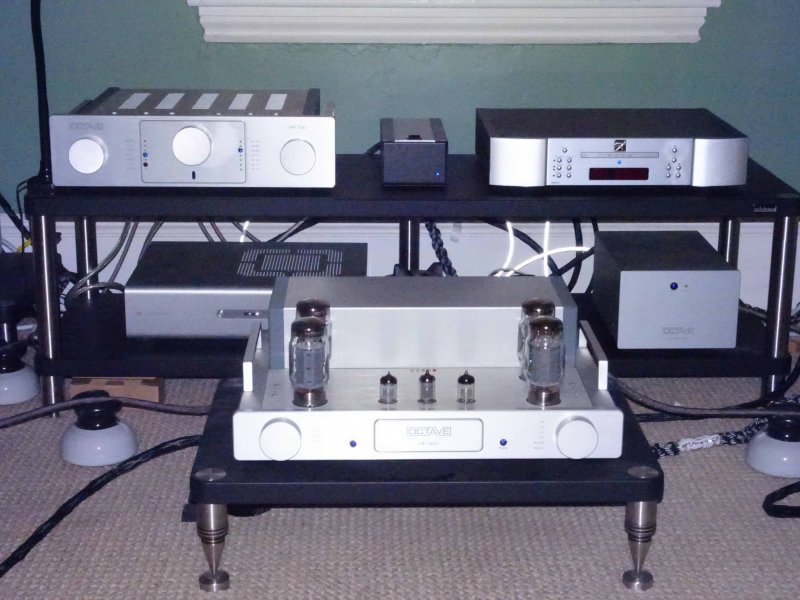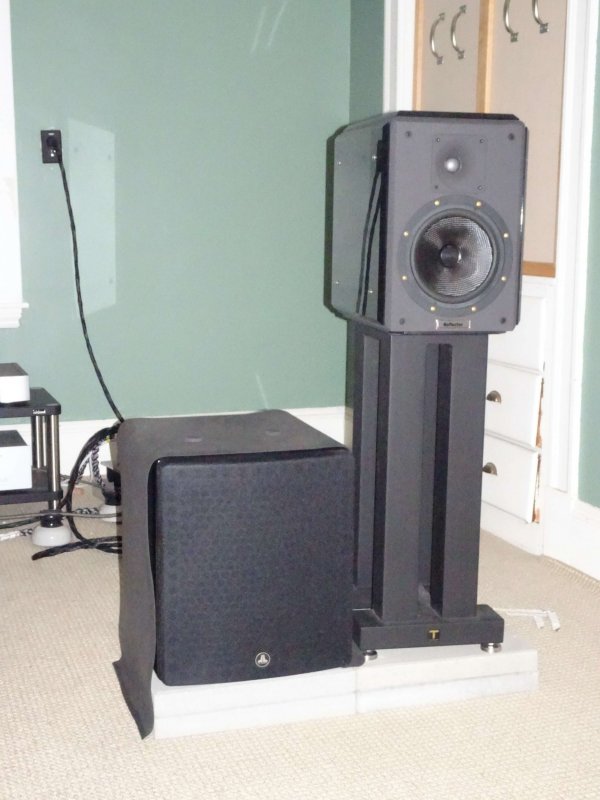A WBF member contacted me about these speakers, and asked me about their bass performance without subwoofers. So this afternoon I delved into the interesting exercise to find out. I had already known that bass performance of the monitors on their own was vastly improved since I had moved the subwoofers next to the speakers, rather than having them at the front wall as in my original review (see image in opening post). This was simply a matter of change in room acoustics.
I was really surprised. Rock sounded with good mid-bass weight, drums were fine and bass guitar was nice and articulate. That held for Black Sabbath and Joe Walsh "But Seriously Folks". The biggest surprise though was the jazz rock of the Trio of Doom (John McLaughlin, Jaco Pastorius, Tony Williams). There was lots of weight on drums and bass, and even kick drum had some weight to it. I really didn't miss any heft in the mid-bass, and there is not really much low bass on this recording to begin with. I kid you not, it was so good that, on this and two other occasions, I slightly touched the outer part of the subwoofer drivers to convince myself that the drivers were indeed not vibrating and the subs were really off! They were, and it was confusing, to be honest.
Stand-up bass in jazz was really good too, and stand up solos had satisfying weight. The low register of piano was impressive, and it could even be thunderous when asked for.
All the latest changes in my system set-up (see link in previous post) obviously bore fruit also in the bass performance of the monitors in standalone mode. One thing that definitely helped was also the removal of the TubeTraps. These are known to cause some mid-bass suck out (on the positive side, they greatly help mitigate mid-bass boom in some rooms), and now the mid-bass of these monitors is really impressive. Certainly, there is little low bass, but even the repeated heavy bass drum rolls at about three quarters into Stravinsky's Rite of Spring had some satisfying weight. Yes, the extra low bass authority was not there, but it was not that I was really missing it that much.
I already knew that the mid-bass on "Bad Guy" by Billie Eilish with the monitors alone was really good, and I confirmed it this afternoon. Sure, the earthshaking low bass of this and other electronica was not there, and turning on the subs showed again how impressive it is on this Billie Eilish track and entire recording. Yet you just don't get this kind of low bass from normal floor standers either, and calling any multi-way floor stander a "full-range speaker" per usual audiophile convention is ridiculous in my view. Only large floor standers -- and mostly just those with matching bass towers that already come with the design -- are full range, everything else is just not.
Anyway, I am really impressed with the bass performance of these Reflector monitors, in my wooden house (no enforcement by concrete walls) and with the speaker drivers 7 feet away from the front wall, i.e., without direct wall enforcement. The bass is just as good as other reviewers describe, and much better than I was able to report in my own original review due to room and system set-up.
I was really surprised. Rock sounded with good mid-bass weight, drums were fine and bass guitar was nice and articulate. That held for Black Sabbath and Joe Walsh "But Seriously Folks". The biggest surprise though was the jazz rock of the Trio of Doom (John McLaughlin, Jaco Pastorius, Tony Williams). There was lots of weight on drums and bass, and even kick drum had some weight to it. I really didn't miss any heft in the mid-bass, and there is not really much low bass on this recording to begin with. I kid you not, it was so good that, on this and two other occasions, I slightly touched the outer part of the subwoofer drivers to convince myself that the drivers were indeed not vibrating and the subs were really off! They were, and it was confusing, to be honest.
Stand-up bass in jazz was really good too, and stand up solos had satisfying weight. The low register of piano was impressive, and it could even be thunderous when asked for.
All the latest changes in my system set-up (see link in previous post) obviously bore fruit also in the bass performance of the monitors in standalone mode. One thing that definitely helped was also the removal of the TubeTraps. These are known to cause some mid-bass suck out (on the positive side, they greatly help mitigate mid-bass boom in some rooms), and now the mid-bass of these monitors is really impressive. Certainly, there is little low bass, but even the repeated heavy bass drum rolls at about three quarters into Stravinsky's Rite of Spring had some satisfying weight. Yes, the extra low bass authority was not there, but it was not that I was really missing it that much.
I already knew that the mid-bass on "Bad Guy" by Billie Eilish with the monitors alone was really good, and I confirmed it this afternoon. Sure, the earthshaking low bass of this and other electronica was not there, and turning on the subs showed again how impressive it is on this Billie Eilish track and entire recording. Yet you just don't get this kind of low bass from normal floor standers either, and calling any multi-way floor stander a "full-range speaker" per usual audiophile convention is ridiculous in my view. Only large floor standers -- and mostly just those with matching bass towers that already come with the design -- are full range, everything else is just not.
Anyway, I am really impressed with the bass performance of these Reflector monitors, in my wooden house (no enforcement by concrete walls) and with the speaker drivers 7 feet away from the front wall, i.e., without direct wall enforcement. The bass is just as good as other reviewers describe, and much better than I was able to report in my own original review due to room and system set-up.



















